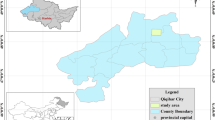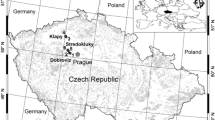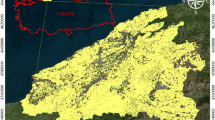Abstract
Windbreaks are a major component of agroforestry practices and play an important role in agroforestry ecosystems. They can reduce wind velocity and protect shelter crops from wind damage and soil from wind erosion. Porosity is one of the most important structural parameters that affect wind speed and is widely used in the study of wind protection provided by windbreaks. In this paper, a method to estimate porosity using high-resolution satellite imagery is represented. Porosity was difficult to estimate through the direct use of remote sensing data due to the poor relationship with vegetation indices. Thus, two intermediate variables, that is, CL 2 × LAI and CL × LAI × W, which were highly related to porosity, were selected. Leaf area index (LAI) and average tree crown length (CL) were estimated using vegetation indices, and W, which refers to the width of a windbreak, was identified using object-based image analysis. Porosity was estimated using a statistical relationship between porosity and intermediate variables. The average prediction accuracy of the estimated porosity value was 76.104 %. Based on the estimated porosity value, the windbreaks were grouped into three types, and their efficiency of wind protection was evaluated. The evaluation result indicated that the windbreaks have a very good protective structure in the study area and they can effectively shelter crops from wind damage and erosion. This study can provide a useful guide for studying the wind protection provided by windbreaks on spatial and temporal scales using remote sensing.





Similar content being viewed by others
References
Alexander C, Bøcher PK, Arge L, Svenning J-C (2014) Regional-scale mapping of tree cover, height and main phenological tree types using airborne laser scanning data. Remote Sens Environ 147:156–172
Bean A, Alperi RW, Federer C (1974) A method for categorizing shelterbelt porosity. Agric Meteorol 14:417–429
Boegh E, Søgaard H, Broge N, Hasager C, Jensen N, Schelde K, Thomsen A (2002) Airborne multispectral data for quantifying leaf area index, nitrogen concentration, and photosynthetic efficiency in agriculture. Remote Sens Environ 81:179–193
Buck LE, Lassoie JP, Fernandes EC (1998) Agroforestry in sustainable agricultural systems. CRC Press, Boca Raton
Carlson TN, Ripley DA (1997) On the relation between NDVI, fractional vegetation cover, and leaf area index. Remote Sens Environ 62:241–252
Chen JM, Black T (1992) Defining leaf area index for non-flat leaves. Plant, Cell Environ 15:421–429
Chen JM, Cihlar J (1996) Retrieving leaf area index of boreal conifer forests using Landsat TM images. Remote Sens Environ 55:153–162
Cleugh H (1998) Effects of windbreaks on airflow, microclimates and crop yields. Agrofor Syst 41:55–84
Deng R, Li Y, Wang W, Zhang S (2013) Recognition of shelterbelt continuity using remote sensing and waveform recognition. Agrofor Syst 87:827–834
Dong J, Kaufmann RK, Myneni RB, Tucker CJ, Kauppi PE, Liski J, Buermann W, Alexeyev V, Hughes MK (2003) Remote sensing estimates of boreal and temperate forest woody biomass: carbon pools, sources, and sinks. Remote Sens Environ 84:393–410
Gebreslasie M, Ahmed F, Van Aardt JA (2010) Predicting forest structural attributes using ancillary data and ASTER satellite data. Int J Appl Earth Obs Geoinf 12:S23–S26
GF-1 satellite (2014a). http://www.cresda.com/EN/satellite/7155.shtml
GF-1 satellite of China (2014b). http://www.wmo-sat.info/oscar/satellites/view/588
Gilabert M, González-Piqueras J, Garcıa-Haro F, Meliá J (2002) A generalized soil-adjusted vegetation index. Remote Sens Environ 82:303–310
Gower ST, Kucharik CJ, Norman JM (1999) Direct and indirect estimation of leaf area index, fAPAR, and net primary production of terrestrial ecosystems. Remote Sens Environ 70:29–51
Gray J, Song C (2012) Mapping leaf area index using spatial, spectral, and temporal information from multiple sensors. Remote Sens Environ 119:173–183
Guan W, Li C, Li S, Fan Z, Xie C (2002) Improvement and application of digitized measure on shelterbelt porosity. J Appl Ecol 13:651–657
Heisler GM, Dewalle DR (1988) 2. Effects of windbreak structure on wind flow. Agric Ecosyst Environ 22:41–69
Huete A, Liu H, Batchily K, Van Leeuwen W (1997) A comparison of vegetation indices over a global set of TM images for EOS-MODIS. Remote Sens Environ 59:440–451
Imhoff ML (1995) A theoretical analysis of the effect of forest structure on synthetic aperture radar backscatter and the remote sensing of biomass. IEEE Trans Geosci Remote Sens 33:341–352
Jiang Z, Huete AR, Didan K, Miura T (2008) Development of a two-band enhanced vegetation index without a blue band. Remote Sens Environ 112:3833–3845
Jordan CF (1969) Derivation of leaf-area index from quality of light on the forest floor. Ecology 50:663–666
Kenney W (1987) A method for estimating windbreak porosity using digitized photographic silhouettes. Agric For Meteorol 39:91–94
Köhl M, Päivinen R (1996) Definition of a system of nomenclature for mapping European forests and for compiling a pan-European forest information system. Office for Official Publications of the European Communities, Luxembourg
Lefsky MA, Cohen W, Acker S, Parker GG, Spies T, Harding D (1999) Lidar remote sensing of the canopy structure and biophysical properties of Douglas-fir western hemlock forests. Remote Sens Environ 70:339–361
Loeffler A, Gordon A, Gillespie T (1992) Optical porosity and windspeed reduction by coniferous windbreaks in Southern Ontario. Agrofor Syst 17:119–133
López-Lozano R, Baret F, Chelle M, Rochdi N, España M (2007) Sensitivity of gap fraction to maize architectural characteristics based on 4D model simulations. Agric For Meteorol 143:217–229
McNaughton K (1988) 1. Effects of windbreaks on turbulent transport and microclimate. Agric Ecosyst Environ 22:17–39
Mize C, Brandle JR, Schoeneberger M, Bentrup G (2008) Ecological development and function of shelterbelts in temperate North America. Toward agroforestry design. Springer, New York, pp 27–54
Næsset E, Økland T (2002) Estimating tree height and tree crown properties using airborne scanning laser in a boreal nature reserve. Remote Sens Environ 79:105–115
Perera M (1981) Shelter behind two-dimensional solid and porous fences. J Wind Eng Ind Aerodyn 8:93–104
Proisy C, Couteron P, Fromard F (2007) Predicting and mapping mangrove biomass from canopy grain analysis using Fourier-based textural ordination of IKONOS images. Remote Sens Environ 109:379–392
Raine J, Stevenson D (1977) Wind protection by model fences in a simulated atmospheric boundary layer. J Wind Eng Ind Aerodyn 2:159–180
Rondeaux G, Steven M, Baret F (1996) Optimization of soil-adjusted vegetation indices. Remote Sens Environ 55:95–107
Sader SA, Waide RB, Lawrence WT, Joyce AT (1989) Tropical forest biomass and successional age class relationships to a vegetation index derived from Landsat TM data. Remote Sens Environ 28:143–198
Saito T. (1996) Relationship between the profiles of wind velocity and gap fraction recorded by hemispherical photographs in a deciduous (broad-leaved) forest. J Jpn For Soc 78:384–389 (Jpn)
Schlerf M, Atzberger C (2006) Inversion of a forest reflectance model to estimate structural canopy variables from hyperspectral remote sensing data. Remote Sens Environ 100:281–294
Schoeneberger MM, Bentrup G, Francis CA (2001) 16 Ecobelts: reconnecting agriculture and communities. Interactions between agroecosystems and rural communities. CRC Press, Boca Raton, pp 239–260
Shrestha R, Wynne RH (2012) Estimating biophysical parameters of individual trees in an urban environment using small footprint discrete-return imaging lidar. Remote Sens 4:484–508
St-Onge BA, Cavayas F (1997) Automated forest structure mapping from high resolution imagery based on directional semivariogram estimates. Remote Sens Environ 61:82–95
Tamang B, Andreu MG, Friedman MH, Rockwood DL (2012) Windbreak designs and planting for Florida agricultural fields. FOR227. Gainesville: University of Florida Institute of Food and Agricultural Sciences. Reviewed October 2015 from http://edis.ifas.ufl.edu
Tomppo E, Nilsson M, Rosengren M, Aalto P, Kennedy P (2002) Simultaneous use of Landsat-TM and IRS-1C WiFS data in estimating large area tree stem volume and aboveground biomass. Remote Sens Environ 82:156–171
Torita H, Satou H (2007) Relationship between shelterbelt structure and mean wind reduction. Agric For Meteorol 145:186–194
Vigiak O, Sterk G, Warren A, Hagen LJ (2003) Spatial modeling of wind speed around windbreaks. Catena 52:273–288
Wang H, Takle ES (1996) On three-dimensionality of shelterbelt structure and its influences on shelter effects. Bound-Layer Meteorol 79:83–105
Wang H, Takle ES (1997) Momentum budget and shelter mechanism of boundary-layer flow near a shelterbelt. Bound-Layer Meteorol 82:417–437
Wang XQ, Li ZY, Liu XE, Deng G, Jiang ZH (2007) Estimating stem volume using QuickBird imagery and allometric relationships for open Populus xiaohei plantations. J Integr Plant Biol 49:1304–1312
Wilson JD (2004a) Oblique, stratified winds about a shelter fence. Part I: measurements. J Appl Meteorol 43:1149–1167
Wilson JD (2004b) Oblique, stratified winds about a shelter fence. Part II: comparison of measurements with numerical models. J Appl Meteorol 43:1392–1409
Wiseman G, Kort J, Walker D (2009) Quantification of shelterbelt characteristics using high-resolution imagery. Agric Ecosyst Environ 131:111–117
Yu Y, Yang X, Fan W (2015) Estimates of forest structure parameters from GLAS data and multi-angle imaging spectrometer data. Int J Appl Earth Obs Geoinf 38:65–71
Zheng S, Cao C, Dang Y, Xiang H, Zhao J, Zhang Y, Wang X, Guo H (2014) Retrieval of forest growing stock volume by two different methods using Landsat TM images. Int J Remote Sens 35:29–43
Zhou X, Jiang F, Zhu J (1991) Study on random error of shelterbelt porosity estimated by measuring photo with the help of digitized photographic silhouettes. Chin J Appl Ecol 2:193–202
Zhu J, Matsuzaki T, Gonda Y (2003) Optical stratification porosity as a measure of vertical canopy structure in a Japanese coastal forest. For Ecol Manag 173:89–104
Zhu T, Guan D, Wu J, Jin C (2004) Structural parameters of wind protection of shelterbelts and their application. Sci Silvae Sin 40:9–14
Acknowledgments
We would like to express our gratitude to Yibo Wen, Zhichao Zhang, and Yuhang Wang for their considerable hard work in the field data collection. This work is financially supported by the Special Fund for Forest Scientific Research in the Public Welfare, Grant Number: 201404202.
Author information
Authors and Affiliations
Corresponding authors
Appendix
Appendix
See Table 7.
Rights and permissions
About this article
Cite this article
Yang, X., Yu, Y. & Fan, W. A method to estimate the structural parameters of windbreaks using remote sensing. Agroforest Syst 91, 37–49 (2017). https://doi.org/10.1007/s10457-016-9904-4
Received:
Accepted:
Published:
Issue Date:
DOI: https://doi.org/10.1007/s10457-016-9904-4




